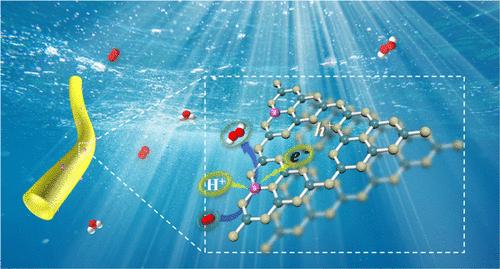O–O Bond Homolysis Inhibition Strategy on B-g-C3N4 Boosts Selectivity for the Photosynthesis of H2O2
IF 4.7
2区 化学
Q1 CHEMISTRY, INORGANIC & NUCLEAR
引用次数: 0
Abstract
Photocatalytic oxygen reduction offers a green and sustainable route for hydrogen peroxide production. Among various photocatalysts, graphitic carbon nitride (g-C3N4) stands out owing to its low cost and tunable electronic structure. However, the competing four-electron O2 reduction reaction (ORR) to H2O significantly compromises the selectivity, posing a major challenge for practical applications. In this study, we propose a boron atom decoration strategy on carbon nitride tubes (BCN) to enhance H2O2 production. Combined experimental and theoretical analyses reveal that the incorporation of B atoms facilitates O2 adsorption and inhibits O–O bond homolysis, improving the selectivity of the two-electron ORR pathway to H2O2. Moreover, B atoms, acting as Lewis acid sites, stabilize the •O2– intermediate through acid–base interactions. As a result, the optimized BCN catalyst (BCN400) achieves a remarkable H2O2 yield of 30 μmol·h–1, representing a 4-fold increase in H2O2 production. This study provides a novel strategy for the design of photocatalysts with optimized active sites, offering significant potential for a wide range of applications in sustainable chemical production.

抑制B-g-C3N4的O-O键均解策略提高H2O2光合作用的选择性
光催化氧还原为过氧化氢的生产提供了一条绿色和可持续的途径。在各种光催化剂中,石墨氮化碳(g-C3N4)因其低成本和可调谐的电子结构而脱颖而出。然而,竞争的四电子O2还原反应(ORR)对H2O的选择性显著降低,对实际应用构成了重大挑战。在这项研究中,我们提出了硼原子修饰碳氮管(BCN)的策略,以提高H2O2的产量。实验与理论相结合分析表明,B原子的加入促进了O2的吸附,抑制了O-O键的均裂,提高了双电子ORR途径对H2O2的选择性。此外,B原子作为Lewis酸位点,通过酸碱相互作用稳定•O2 -中间体。结果表明,优化后的BCN催化剂(BCN400) H2O2产率达到30 μmol·h-1, H2O2产率提高了4倍。该研究为设计具有优化活性位点的光催化剂提供了一种新的策略,在可持续化工生产中具有广泛的应用潜力。
本文章由计算机程序翻译,如有差异,请以英文原文为准。
求助全文
约1分钟内获得全文
求助全文
来源期刊

Inorganic Chemistry
化学-无机化学与核化学
CiteScore
7.60
自引率
13.00%
发文量
1960
审稿时长
1.9 months
期刊介绍:
Inorganic Chemistry publishes fundamental studies in all phases of inorganic chemistry. Coverage includes experimental and theoretical reports on quantitative studies of structure and thermodynamics, kinetics, mechanisms of inorganic reactions, bioinorganic chemistry, and relevant aspects of organometallic chemistry, solid-state phenomena, and chemical bonding theory. Emphasis is placed on the synthesis, structure, thermodynamics, reactivity, spectroscopy, and bonding properties of significant new and known compounds.
 求助内容:
求助内容: 应助结果提醒方式:
应助结果提醒方式:


